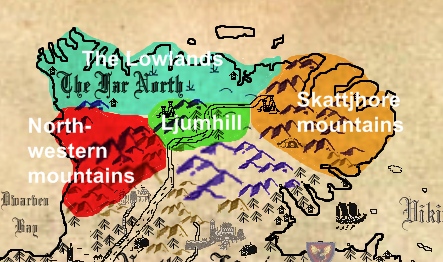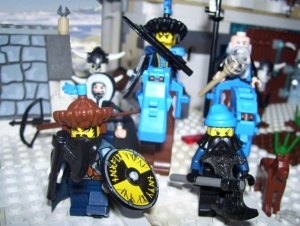Gelojhor tribes
From Legonia
Ancient tribes
Humos -
Muckar -
Insaani
Northern peoples
Amazones -
Gelohjor -
Northlegonians-
Northmen -
Vikings
Southlegonian peoples
Ark'tohlians -
Atlaua -
Insulans
Eastern peoples
Anubans -
Castallanians
Orlanians -
Therians -
Other
People of Peng Cheng -
Romti -
Ystel people
In the far north , some low populated human tribes try to survive in one of the coldest environments of Legonia.
Contents |
History
| Gelojhor tribes | ||||||||||||||||||||||||||
|---|---|---|---|---|---|---|---|---|---|---|---|---|---|---|---|---|---|---|---|---|---|---|---|---|---|---|

| ||||||||||||||||||||||||||
| Blazon:ruined viking shield | ||||||||||||||||||||||||||
| Barbarian families | ||||||||||||||||||||||||||
| Ruler | Tribe Elders | |||||||||||||||||||||||||
| Capitol | Ljumhill settlements | |||||||||||||||||||||||||
| Foundation | unknown | |||||||||||||||||||||||||
| Data | ||||||||||||||||||||||||||
| People | ~3000 Gelojhor; 300 Vikings&Northmen | |||||||||||||||||||||||||
| Language | Modern Legonian; Gelo tongue | |||||||||||||||||||||||||
| Religion | The big Something;mostly atheism | |||||||||||||||||||||||||
| Economy | Self-Supportment; fishing; hunting | |||||||||||||||||||||||||
| Region | The Far North | |||||||||||||||||||||||||
| Neighbours | ||||||||||||||||||||||||||
| ||||||||||||||||||||||||||
| Position | ||||||||||||||||||||||||||
Origin and isolation
1000-1300 o.C. barbarian tribes settled first along the northern mountains. Historians assume that those wild people seperated into 3 main groups. The Northmen, who created the Dragon Empire later, the vikings, who stayed at the viking coast and the Gelohjor, who went into the far north.
Over the centuries, the Gelohjor created their own culture in a hard environment, where they had nearly nothing while the vikings and northmen developed in richer regions. Soon, the relationships became bad by enviousness and betrayal in different tradings. So, the Dragon Empire bought furs and skins from the Gelohjor for worthless payments or often without sending soemthing back. Only the big northern mountains and other problems pretended military incidents.
Since begin of the 16th century in the old chronology, there's no contact between the peoples. Meanwhile hate and predjudices developed on both sides.
Reopening and New Age
Nobody knows, how Gelohjor history changed and the few wild tribes never wrote anything, so the complete 16th and first half of the 17th century are unknown.
In the New Age vikings start to explore the world north of their territories and created first settlements in Ljumhill along the Regin river. Contacts between Gelohjor and vikings are rare and agressive. There wasn't bigger battles yet nor a real war, but noone trust each other. The Gelojhor think that the vikings only come to rob treasures from secret mountain caves, the vikings think, that Gelohjor warriors would try to conquer viking land.
Politics
There's no central government in the north. The few settlements are too far away from each other, so tribe councils or familiy elders decide bigger questions. In the bigger settlements of Ljumhill, the councils can change quickly by military support, so it's important for a councillor to hold enough men behind himself and stay protected for traitors-
Economy
Only a few hundreds people exist so all Gelojhors are self-supporter. In the lowlands people live from hunting valannats , ice bears or sagfishs. All parts like skin, meat and bones are used for different things.
For fishing, Kajaks and Wojaks are used, for land travel some special horses.
Only in Ljumhill some crafting or lumberjack is done.
In newer times, another important topic of economy was discovered: In the Skattjhore mountains worthful diamonds, crystals and other rare minerals are assummed and foreign vikings came to get these goods.
Culture
According to their relation with the other northern peoples, they have the same cultural basement as the northmen and vikings. But centuries of hard surviving made them more strange. So there's nearly no use of religion althought the name of the big something is known in their language.
Isolated from their brothers, the tongue changed and own words developed but most Gelohjors can understand and talk the modern legonian language.
For a Gelohjor warrior, there's no need of festivals or other kind of entertainment. Tales are told by those, who are too old to work much and children don't have much time to listen because they have to work with their mothers or be trained by their fathers to warriors and hunters.
Females haven't much to say and keep at home. Their jobs are cooking, fishing and collecting plants and berries.
Suicide is a traditional part of life. Those, who get old and weak and can't support their community in any way anymore, get disabled or did honorless failures, kill theirselves by wandering too far into the endless snowfields, a blizzard or jumping into ice water. Punishment for crimes are done by the tribe's leader. A criminal is killed by heading because dying in the nature only honorable men deserve.
Military
There're a few bigger settlements, where leaders control over smaller warrior groups in fortified ice castles. Gelojhore are known as barbarian warriors and use giant axes. The main colours are blue and black. For symbols, viking origins are used.
Mocs:



